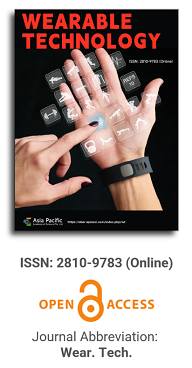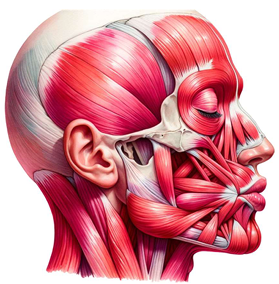

This paper delves deeply into the innovative realm of integrating human emotions with wearable technology. The primary focus is on the conceptualization and development of a kiss transfer device that harnesses the power of wearable technology to bridge the physical gap in human-human interactions. By investigating the intricate nuances of the human-human kissing process, the research seeks to replicate this intimate gesture through a technological medium. The paper not only elaborates on the anatomy, evolution, and hormonal dynamics of kissing but also underscores the transformative potential of wearable technology in capturing and transmitting these intimate moments. This exploration opens up new horizons for long-distance relationships, offering a tangible touchpoint that goes beyond traditional communication methods. Through this pioneering work, the research positions wearable technology as not just a tool for communication but as an extension of our human emotions and expressions.

Systematic-interdisciplinary approach to eHealth equipment design
Vol 2, Issue 1, 2021
Download PDF
Abstract
eHealth has improved the performance of multiple health systems worldwide by integrating Information and Communication Technologies (ICTs) into national (structured and coordinated) strategies in the health sector. However, once the foundation is laid for the development and implementation of eHealth solutions, researchers, engineers, doctors and other stakeholders have no single way to develop eHealth solutions. Therefore, a systematic interdisciplinary method is proposed to design electronic health equipment to meet the requirements and needs of all people involved in the use of the equipment, and comply with the laws and regulations of different countries.
On the basis of systematic and interdisciplinary methods, a method is proposed, that is, the collaborative use of different systematic methods allows stakeholders to continue to cooperate and share the experience. Consequently, the method will allow the design of eHealth devices that, regardless of their use, meet the needs of the user, the requirements of the personnel who will use them, the standards and regulations of the country where they are developed, and provide total satisfaction with the device. Finally, the eHealth solution is designed through systematic thinking, through the analysis of needs and needs, and through exploring different perspectives, observation backgrounds, participant participation, discussion and stakeholder consistency, so as to provide a sustainable product that meets all participants.
Keywords
References
- Shivakumar NS, Arora M, Mani M. A Proposed design of an universal electrochemical reader based on a collated medical device innovation framework and systems thinking. Proc. 4th Int Conf. Biosignals Images Instrumentation; 2018 Mar 22–24; Chennai: IEEE; 2018. p. 206–212.
- Bedson J, et al. Development and validation of a pain monitoring app for patients with musculoskeletal conditions (The Keele pain recorder feasibility study). BMC Med. Inform. Decis. Mak 2019; 19(1): 1–13.
- World Health Organization. Aplicación del Pensamiento Sistémico al Fortalecimiento de los Servicios de Salud. Francia: Alianza Para La Investigación en Políticas y Sistemas de Salud, 2009.
- Ackoff RL, Warfield JN. Redesigning the future, a systems approach to societal problems. IEEE Trans. Syst. Man. Cybern 1977; 7(10): 759.
- Checkland P, Poulter J. Learning for action: A short definitive account of soft systems methodology, and its use practitioners, teachers and students. USA: John Wiley & Sons, 2007.
- Eysenbach G. What is e-health? J. Med. Internet Res 2001; 3(2): 1–5.
- World Health Organization [Internet]. eHealth. [cited 2017 Mar 22] Available from: http://www.emro.who.int/health-topics/ehealth/.
- Scott RE, Mars M. Principles and framework for eHealth strategy development. J. Med. Internet Res 2013; 15(7): e155.
- Sauermann S. eHealth strategies-scientific review report considering national and regional eHealth strategies and results from science. Viena 2016.
- World Health Organization and International Telecommunication Union (2012). National eHealth strategy toolkit. International Telecommunication Union, pp. 1–2.
- Von Bertalanffy L. The history and status of general systems theory. Acad. Manag. J 1972; 15(4): 407–426.
- Rosnay J. The macroscope: A new world scientific system. California, USA: Harper & Row 1979.
- Gay A. Los sistemas y el enfoque sistémico, Semin [Systems and the systemic approach, Semin]. Iberoam. Estud. Socioeconómicos 1995; 12.
- Laszlo A, Krippner S. Systems theories: Their origins, foundations, and development. In: Jordan JS (ed). Systems theories and a priori aspects of perception, 1998, pp. 47–74.
- Arnold RD, Wade JP. A definition of systems thinking: A systems approach. Procedia Comput 2015; 44: 669–678.
- Piaget J. L’Epistémologie des relations interdisciplinaires [The epistemology of interdisciplinary relations]. L’interdisciplinarité problèmes d’enseignement Rech Dans les Univ 1972; 155–171.
- Nicolescu B. Methodology of transdisciplinarity-Levels of Reality, Logic of the Included Middle and Complexity. Transdiscipl. J. Eng. Sci 2010; 1(1): 19–38.
- Nicolescu B. Methodology of transdisciplinarity. World Futures 2014; 70(3–4): 186–199.
- Bernstein JH. Interdisciplinarity: A review of its origins, development, and current issues. Journal of Research Practice 2016; 11(1): 1–20.
- Jackson MC. Critical systems thinking and the management of complexity. Chichester, UK: Wiley & Sons 2019.
- Tariq A, Tanwani A, Farooq M. User centered design of eHealth applications for remote patient management. Hum Factors 2009.
- Van Velsen L, Wentzel J, Van Gemert-Pijnen JE. Designing eHealth that matters via a multidisciplinary
- requirements development approach. JMIR Res. Protoc. 2013; 2(1): e21.
- Celik N, Balachandran W, Manivannan N, et al. Wearable mobile ear-based ECG monitoring device using graphene coated sensors. Proc. IEEE Sensors 2017; 1–3.
- Verhees B, Van Kuijk K, Simonse L. Care model design for e-health: Integration of point-of-care testing at dutch generalpractices. Int. J. Environ. Res. Public Health 2018; 15(1): 1–16.
- Almeida AMP, Almeida HS, Figueiredo-Braga M. Mobile solutions in depression: Enhancing communication with patients using an SMS-based intervention. Procedia Comput. Sci 2018; 138: 89–96.
- Sousa M. A platform to support the care and assistance of community-dwelling older adults. Procedia Comput. Sci 2018; 138l: 197–202.
- Monteiro K, Rocha E, Silva E, et al. (2019). Developing an e-health system based on IoT, Fog and
- cloud computing. Proc.-11th IEEE/ACM Int. Conf. Util. Cloud Comput; 2018 Dec 17–20; Zurich: IEEE; 2019. p. 17–18.
- Shanin F. Portable and centralised e-Health record system for patient monitoring using Internet of Things (IoT). 2018 Int. CET Conf. Control. Commun. Comput; 2018 Jul 5–7; Thiruvananthapuram: IEEE; 2018. p. 165–170.
- Monton JLB, Martinez-Millana A, Han W, et al. Wearable sensors integrated with internet of things for advancing ehealth care. Sensors (Switzerland) 2018; 18(6): 1–18.
- Shokrekhodaei M, Quinones S, Martinek R, et al. A robust PPG-based heart rate monitor for fitness and eHealth applications. 2018 IEEE 20th Int. Conf. e-Health Networking Appl. Serv. Heal; 2018 Sept 17–20; Ostrava: IEEE; 2018. p. 1–5.
- García L, Tomás J, Parra L, et al. An m-health application for cerebral stroke detection and monitoring using cloud services. Int. J. Inf. Manage 2018; 45: 319–327.
- Celesti A. How to develop IoT cloud e-Health systems based on FIWARE: A lesson learnt. J. Sens. Actuator Networks 2019; 8(1):7.
- Vossebeld DM, Puik ECN, Jaspers JEN et al. Development process of a mobile electronic medical record for nurses: A single case study. BMC Med. Inform. Decis. Mak 2019; 19(1): 1–12.
- Pierleoni P. A eHealth system for atrial fibrillation mon-itoring. In: Leone A, Caroppo G, Rescio G, Diraco G, Siciliano P (eds). Ambient assisted living, 2019, pp. 229–241.
- Domingues MF. Insole optical fiber sensor architecture for remote gait analysis—An e-Health solution. IEEE Internet Things J. 2019; 6(1): 207–214.
- Mair FS, May C, O’Donnell C, et al. Factors that promote or inhibit the implementation of e-health systems: An explanatory systematic review. Bull. World Health Organ 2012; 90(5): 357–364.
- Ross J, Stevenson F, Lau R, et al. Factors that influence the implementation of e-health: A systematic review of systematic reviews (an update). Implement. Sci 2016; 11(1): 1–12.
- Granja C, Janssen W, Johansen MA. Factors determining the success and failure of ehealth interventions: Systematic review of the literature. J. Med. Internet Res. 2018; 20(5): e10235.
- Privitera MB, Evans M, and Southee D. Human factors in the design of medical devices—Approaches to meeting international standards in the European Union and USA. Appl. Ergon. 2017; 59: 251–263.
- Bach C, Tamsin M. The design of medical devices. Int. J. Innov. Sci. Res 2014; 1(2): 127–134.
- Gilman BL, Brewer JE, Kroll MW. Medical device design process. 2009 Annual International Conference of the IEEE Engineering in Medicine and Biology Society; 2009 Sept 1; Minneapolis: IEEE; p. 5609–5612.
- Çetin A. Applying product design methods to medical device design with a case study on home care devices. Izmir Institute of Technology. 2004.
- Martin JL, Norris BJ, Murphy E, et al. Medical device development: The challenge for ergonomics Appl. Ergon 2008; 39(3): 271–283.
- Böhmer AI, Zöllner AM, Kuhl E, et al. Medical device design process: A medical engineering perspective. Proc. Int. Des. Conf. Des 2014. p. 749–758.
Supporting Agencies
Copyright (c) 2021 José Rodrigo Espinoza-Bautista, Salvador Álvarez-Ballesteros, Chadwick Carreto-Arellano, Julián Patiño-Ortiz, Mario Romero-Castro

This work is licensed under a Creative Commons Attribution 4.0 International License.

Prof. Zhen Cao
College of Information Science & Electronic Engineering, Zhejiang University
China, China
Processing Speed
-
-
-
- <5 days from submission to initial review decision;
- 62% acceptance rate
-
-
Asia Pacific Academy of Science Pte. Ltd. (APACSCI) specializes in international journal publishing. APACSCI adopts the open access publishing model and provides an important communication bridge for academic groups whose interest fields include engineering, technology, medicine, computer, mathematics, agriculture and forestry, and environment.





